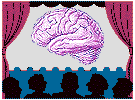 |
Neuroscience at the Movies |  |
| These lessons were developed by Ms. Heather Stewart, Neuroscience for Kids Consultant | ||
At the MoviesThe visual media are powerful attention-grabbers - whether for informing, selling, entertaining or educating. Filmmakers have honed their skills to a fine art. Movies have a finger on the pulse of our society and represent a group vision that reflects the experiences and views of the writers and becomes translated through the directors and actors that interpret and present the story.
Topics SelectedTopics and groups of movies are chosen because of relevance to field of neuroscience. As with other body systems, the nervous system has many time points in its development when disruption and resulting disorders may occur. Prenatal conditions affecting nervous system functioning include hereditary diseases and perinatal disorders which occur around the time of birth (e.g. cerebral palsy). After birth, childhood illnesses may affect development of nervous and sensory systems. Even the amount and type of human contact and socialization may alter the course of normal development (e.g. feral child syndrome). Later, accidents (e.g., trauma), disease (e.g. polio, rabies) and environmental influences (e.g. loudness-induced deafness) may contribute to disturbed neurological functioning. Sometimes the body turns against itself in developing autoimmune disorders with neurological consequence (e.g., multiple sclerosis).
Specific Movies Selected The movies presented in these reviews were chosen not only for their
relevance to the topic being described, but also to stand alone in terms
of quality entertainment. Many more movies were viewed than were chosen
for inclusion. Typically movies were excluded if the topic was not a
significant point addressed in film such as when the disorder was a plot
twist as opposed to an integral part of the film. Also, discretion was
exercised in excluding films in which extreme violence or other
inappropriate themes overwhelmed potential educational aspects of the
film. Suggested grade levels (elementary, middle or high school) are given
as the MINIMUM suggested viewing range, but are by no means intended as
the maximum grade level that would benefit from viewing that
film.
The movies presented in these reviews were chosen not only for their
relevance to the topic being described, but also to stand alone in terms
of quality entertainment. Many more movies were viewed than were chosen
for inclusion. Typically movies were excluded if the topic was not a
significant point addressed in film such as when the disorder was a plot
twist as opposed to an integral part of the film. Also, discretion was
exercised in excluding films in which extreme violence or other
inappropriate themes overwhelmed potential educational aspects of the
film. Suggested grade levels (elementary, middle or high school) are given
as the MINIMUM suggested viewing range, but are by no means intended as
the maximum grade level that would benefit from viewing that
film. | ||
Information for TeachersTo get the most out of these films, as always, preparation is key and depends on the approach to the material. If these topics are studied as "stand-alone" topics (e.g., for National Blindness Awareness Month) or diversity awareness activities (e.g., cognitive impairment), then preparation may be limited to previewing the film(s) while making notes on the teacher preview sheet and providing students with a partially completed student viewing worksheet. If the topic is related to specific study of the nervous system, an additional nervous system information sheet and lesson is recommended to study the topic.
It is ALWAYS recommended that you preview the film prior to including it
as part of a lesson (even if you have viewed it before) so that you
may:
The teacher preview sheet will help you divide the films at appropriate times to fit in with your schedule. Having students fill in the Student Viewing Worksheet with some pre-printed info (name/yr/type/actors/condition being studied) will help focus student attention on the topic. While viewing the films, students can fill in characters, setting, plot, favorite lines. If a film is assigned as an outside assignment, it is recommended that you provide student with a viewing sheet as discussed above to help focus on specific issues and important aspects of the film. |
Information for StudentsIf you are picking a topic for class, you may want to print a copy of the student viewing worksheet to to help organize information for viewing. (Your teacher may already provide one for you.) After you select a topic, read the introduction at the top of the page and make sure you understand the basics. If not, check with your teacher or check the links at the bottom of the page for further information. Also, if this is for a class assignment, make sure that you have cleared the topic and film(s) with your teacher. | |
 Movie Topics | ||
| Amnesia | Autism | Blindness |
| Deafness | Cognitive Impairment | Feral Children |
| Post-Traumatic Stress Disorder | Brain Tumors | Coma |
 Find the
movies in this on-line WORDSEARCH
puzzle. Find the
movies in this on-line WORDSEARCH
puzzle.Also, see Psychiatry in Cinema, Movies for Psychology Students and And The Winner Is: Inviting Hollywood into the Neuroscience Classroom. |

 Movies can be effective teaching tools because they appeal to visual and
auditory modes of learning. The story telling method, as old as humanity,
is infinitely more captivating than the listing of facts and details on a
given topic. Additionally, focusing on a given topic and viewing a movie
enhances listening and observation skills.
Movies can be effective teaching tools because they appeal to visual and
auditory modes of learning. The story telling method, as old as humanity,
is infinitely more captivating than the listing of facts and details on a
given topic. Additionally, focusing on a given topic and viewing a movie
enhances listening and observation skills. Some disorders have obvious relevance such as specific neurological
conditions relating to sensory (e.g., blindness, deafness) or motor (e.g.,
cerebral palsy) systems. Others formerly considered strictly psychological
or emotional have more recently been found to have a biological or
developmental basis within the nervous system. For example, cognitive
impairment and autism may be due to aberrations of development of the
nervous system; mental illnesses including depression, schizophrenia and
compulsive behavior are thought to reflect disorders of within
neurotransmitter systems.
Some disorders have obvious relevance such as specific neurological
conditions relating to sensory (e.g., blindness, deafness) or motor (e.g.,
cerebral palsy) systems. Others formerly considered strictly psychological
or emotional have more recently been found to have a biological or
developmental basis within the nervous system. For example, cognitive
impairment and autism may be due to aberrations of development of the
nervous system; mental illnesses including depression, schizophrenia and
compulsive behavior are thought to reflect disorders of within
neurotransmitter systems. ![[email]](./gif/menue.gif)

